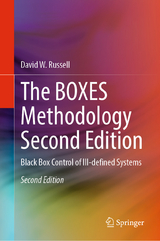The BOXES Methodology
Springer London Ltd (Verlag)
978-1-84996-527-9 (ISBN)
- Lieferbar
- Versandkostenfrei
- Auch auf Rechnung
- Artikel merken
Robust control mechanisms customarily require knowledge of the system’s describing equations which may be of the high order differential type. In order to produce these equations, mathematical models can often be derived and correlated with measured dynamic behavior. There are two flaws in this approach one is the level of inexactness introduced by linearizations and the other when no model is apparent. Several years ago a new genre of control systems came to light that are much less dependent on differential models such as fuzzy logic and genetic algorithms. Both of these soft computing solutions require quite considerable a priori system knowledge to create a control scheme and sometimes complicated training program before they can be implemented in a real world dynamic system.
Michie and Chambers’ BOXES methodology created a black box system that was designed to control a mechanically unstable system with very little a priori system knowledge, linearization or approximation. All the method needed was some notion of maximum and minimum values for the state variables and a set of boundaries that divided each variable into an integer state number. The BOXES Methodology applies the method to a variety of systems including continuous and chaotic dynamic systems, and discusses how it may be possible to create a generic control method that is self organizing and adaptive that learns with the assistance of near neighbouring states.
The BOXES Methodology introduces students at the undergraduate and master’s level to black box dynamic system control , and gives lecturers access to background materials that can be used in their courses in support of student research and classroom presentations in novel control systems and real-time applications of artificial intelligence. Designers are provided with a novel method of optimization and controller design when the equations of a system are difficult or unknown. Researchers interested in artificial intelligence (AI) research and models of the brain and practitioners from other areas of biology and technology are given an insight into how AI software can be written and adapted to operate in real-time.
David W. Russell, Ph.D, C.Eng, FBCS, FIET, FIMechE, is a Professor of Electrical Engineering at Penn State Great Valley, Pennsylvania, USA. His research interests include: applications of artificial intelligence (AI) to real-time, poorly defined control systems, systems engineering, factory information systems, philosophy of machine intelligence, and chaos theory and applications. He has lectured worldwide for many years and has over 30 papers based around the BOXES methodology.
Chapter 1: Introduction.- Part I: Learning and Artificial Intelligence (AI).- Chapter 2: The Game Metaphor.- Chapter 3: Introduction to BOXES.- Chapter 4: Dynamic control as a game.- Part II: The Trolley and Pole.- Chapter 5: Control of a simulated inverted pendulum using the BOXES method.- Chapter 6: The Liverpool experiment.- Chapter 7: Solving the auto-start dilemma.- Part III: Other BOXES applications.- Chapter 8: Continuous system control.- Chapter 9: Other on/off control case studies.- Chapter 10: Two non-linear applications.- Part IV: Improving the Algorithm.- Chapter 11: Accelerated learning.- Chapter 12: Two advising paradigms.- Chapter 13: Evolutionary studies research.- Chapter 14: Conclusions
| Zusatzinfo | 13 Tables, black and white; XXII, 226 p. |
|---|---|
| Verlagsort | England |
| Sprache | englisch |
| Maße | 155 x 235 mm |
| Gewicht | 541 g |
| Themenwelt | Informatik ► Theorie / Studium ► Algorithmen |
| Informatik ► Theorie / Studium ► Künstliche Intelligenz / Robotik | |
| Mathematik / Informatik ► Mathematik ► Angewandte Mathematik | |
| Technik ► Elektrotechnik / Energietechnik | |
| Technik ► Maschinenbau | |
| ISBN-10 | 1-84996-527-7 / 1849965277 |
| ISBN-13 | 978-1-84996-527-9 / 9781849965279 |
| Zustand | Neuware |
| Informationen gemäß Produktsicherheitsverordnung (GPSR) | |
| Haben Sie eine Frage zum Produkt? |
aus dem Bereich





